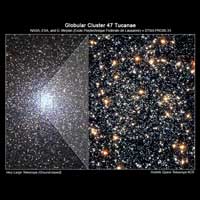News Release Archive: HubbleSite Lite
October 24, 2006 10:00 AM (EDT)
News Release Number: STScI-2006-33
Hubble Yields Direct Proof of Stellar Sorting in a Globular Cluster
October 24, 2006: NASA's Hubble Space Telescope has provided astronomers with the best observational evidence to date that globular clusters sort out stars according to their mass, governed by a gravitational billiard ball game between stars. Heavier stars slow down and sink to the cluster's core, while lighter stars pick up speed and move across the cluster to its periphery. This process, called "mass segregation," has long been suspected for globular star clusters, but has never before been directly seen in action.
A typical globular cluster contains several hundred thousand stars. Although the density of stars is very small in the outskirts of such stellar systems, the stellar density near the center can be more than 10,000 times higher than in the local vicinity of our Sun. If we lived in such a region of space, the night sky would be ablaze with 10,000 stars that would be closer to us than the nearest star to the Sun, Alpha Centauri, which is 4.3 light-years away (or approximately 272,000 times the distance between Earth and the Sun).
Larger Image

Credit: NASA, ESA, and G. Meylan (Ecole Polytechnique Federale de Lausanne)



